Publication from the Tava webite
by Samantha Madell
Theobroma cacao: from Bud to Bean
Samantha Madell describes some methods of cocoa cultivation, harvesting, fermentation, and drying.
(With some cocoa trivia thrown in for good measure).
Good
quality cocoa isn't necessarily about the variety of the bean, or where
it's grown, or whether it's processed by a small-holder or on an
industrial scale. What matters is the quality of fermentation and
drying, because this is the only way to unlock the unique flavours of
each harvest of beans.
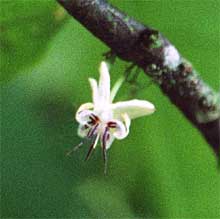 | Cocoa
flowers grow from small cushions on the trunk or older branches of the
tree. The flower has no discernible scent (at least, not to my nose) -
although scientists believe that the nectar emits an odour attractive
to some insects.
Each flower has five sepals and five petals. The
male part of the flower consists of five double stamens, with each
stamen bearing up to four anthers. The female part of the flower
consists of five united carpels, each containing four to twelve locules
(cavities). The number of seeds a cocoa pod can produce is limited by the number of locules in the flower. In other words, it is possible for a pod to produce 20-60 seeds.
The window of opportunity for pollination
is quite small. The flower opens at dawn, and the pollen is released
from the anthers just before sunrise. The stigma is receptive to
pollination only from sunrise to sunset on the day that the flower
opens. If the flower is not pollinated, it usually falls off the next
day. | 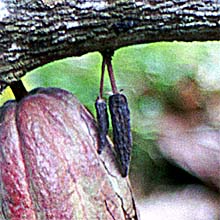 | Less
than 10 per cent of cocoa flowers are successfully pollinated, and only
about 2 per cent of those (i.e. 1 in every 500 flowers) grow into a
mature fruit.
While pollination is normally carried out by insects, higher rates of pollination can be achieved by hand - but cherelle wilt prevents much higher rates of fruit set from being obtained.
Cherelle wilt is a natural fruit thinning mechanism
whereby the young fruit, called cherelles, stop growing, turn black and
shrivel but do not fall off the tree. Cherelle wilt is not a disease.
Boron
has been found to increase pod set and reduce cherelle wilt. Hence, in
some places, boron is applied to trees as an annual foliar spray. | 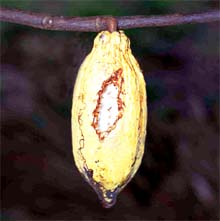 |
Animals
are attracted to the sweet pulp around the seed, not to the seed
itself. The cocoa "pod" in this photo shows the effect of rat attack.
Even though rats leave the actual beans untouched, they are still a
major pest, and cause significant losses for the cocoa industry every
year. | 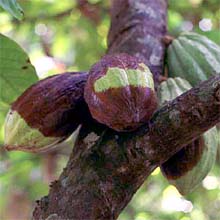 | This photo shows cocoa pods with the widespread fungal disease known as "black pod". Black pod is caused by the fungus Phytophthera.
A
black pod infection starts out as a brown spot which rapidly spreads
over the whole pod, and then to neighbouring pods. Black pod can be
spread by wind, rats, insects, and on human hands.
Cocoa grown in high-humidity climates are most at risk of black pod.
It has been estimated that more than 20% of the annual cocoa crop is lost to various diseases, including black pod. | 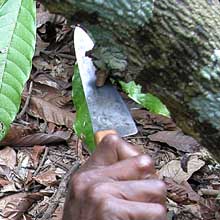 | Harvesting
cocoa pods requires considerable skill because the pods grow on thick
stems, very close to the trunk and branches. The tree itself is highly
vulnerable to damage, which can easily be caused by the blade used for
harvesting.
For example, if a flower cushion is damaged, no flowers
will develop from that spot in future years, while cuts on the tree's
branches or trunk encourage fungal growth. | 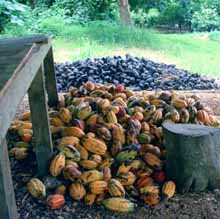 | Freshly harvested cocoa pods are usually taken to a de-husking area, where the cocoa seeds (or "beans") are removed from the pods in preparation for fermentation.
If
the beans are allowed to sit for too long in the harvested pods, the
pulp can dry out, or uncontrolled fermentation can begin inside the pod
- leading to a poor end result, with beans that are either
under-fermented, or rotten.
In this photo, taken in Vanuatu, you can see a pile of ripe pods waiting to have their husks removed.
In the background, you can see the older, empty husks, which have turned black and started to rot away. | 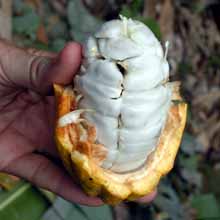 | This picture of a freshly opened pod clearly shows the white mucilage (or "pulp") that encases each of the seeds (or "beans").
The pulp is quite sweet and tangy, and its flavour is reminiscent of mango.
The pulp plays a central role in the fermentation of cocoa beans.
During
fermentation, yeasts grow on the sweet pulp and convert the sugars to
alcohol. The alcohol is oxidised by bacteria - a process that
ultimately produces carbon dioxide, water, and heat. Hence, the pulp
breaks down and drains away. | 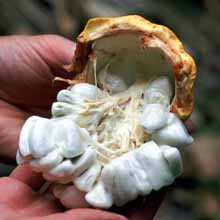 | This image shows the pod's placenta - the rope-like object that attaches the ovules (the seeds / beans) to the ovary (the pod / husk).
The placenta is detached from the beans and discarded before fermentation.
By definition, cocoa beans are not true beans.
True beans are produced by true pods, and the fruit of the cocoa tree
is not a true pod. But common usage means that the cocoa fruit is
almost always referred to as a pod, and cocoa seeds are almost always
referred to as beans. | 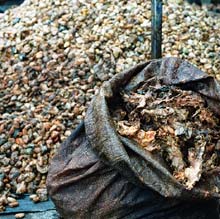 | This image offers several interesting points of comparison. The photo shows a pile of CCN-51 beans recently removed from their pods. This pile will soon be transferred into a fermentation box.
CCN-51 is a high-yielding cocoa hybrid which was developed by Homero Castro in Ecuador in the 1960s.
The sack in the foreground contains the discarded placentas. CCN-51 placentas are extremely thick and woody.
Also, note the colour of the beans in the heap:
they are neither white and firm looking, which would indicate that they
had been freshly harvested; nor are they a bright orangey/brown colour,
which would indicate controlled fermentation. Instead, the beans look slimy and grey,
and when the photo was taken they had an unpleasant odour, indicating
that the beans had been left to sit in the harvested pods for several
days, and had started to rot inside the pods. | 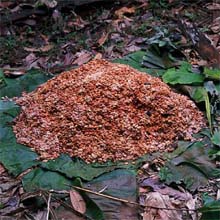 | This is a small fermentation heap on the floor of a cocoa plantation in Vanuatu. Its cover of banana leaves was removed for the photo.
Some
text books say that a heap must contain at least 100 kilograms of beans
in order to ferment properly. However, some of the best beans I have
ever sampled were fermented in heaps like this one, containing less
than 50 kilograms of beans.
During the first two days of
fermentation, the temperature in the heap rises to about 50ºC. It
is important to turn the beans during fermentation, to increase
aeration and bacterial activity. This increases the production of heat,
and breaks down the pulp. Typically, the beans are turned twice during
fermentation. | 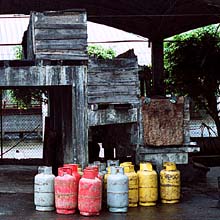 | This is a relatively large scale arrangement of tiered fermentation boxes in Ecuador. (The gas cylinders in the foreground provide fuel for forced drying).
In
this setup, once the beans have been removed from their pods, they are
placed in the top crate, where they begin fermenting. Holes in the
wooden box allow the liquefied pulp to drain away.
The beans are
"turned" by being poured into the lower boxes. To make this step
easier, the front panels on each crate can be removed. The beans are
usually turned after about 48 and 96 hours. | 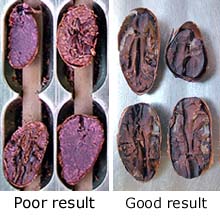 | With correct fermentation
the acetic acid and high temperatures produced kill the cocoa bean
within 24 hours. The bean's death causes its cell walls to break down,
and allows previously separated substances to mix. Chemical changes
then take place within the bean. These changes include enzyme activity,
oxidation, and the breakdown of proteins into amino acids.
The purple polyphenols are converted into insoluble substances which are oxidised, giving a well-fermented bean its characteristic chocolate-brown colour.
The chemical reactions caused by fermentation also begin to develop the
bean's classic chocolate flavour. The length of fermentation varies
depending on the bean type: Forastero beans require 5-6 days, while
Criollo beans may need only 2-3 days.
Images:
The beans from
Ecuador (left) are purple, with a cheesy texture, indicating poor
fermentation; the beans from Vanuatu (right) are brown, with fissures,
indicating good fermentation. | 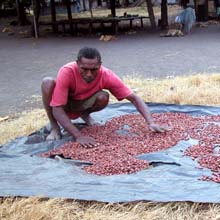 | After fermentation, the cocoa beans must be dried.
The aims of drying
are to halt fermentation, reduce the water content in the bean, and to
drive out the acetic acid which was formed during fermentation.
In some areas where the weather is dry enough, it is possible to dry the beans just by spreading them out in the sun. Sun drying
takes one to two weeks, with the beans being turned about four times
per day. Each night, the beans are put into sacks and placed under
cover.
If cocoa beans are not adequately dried, they are likely to go mouldy. | 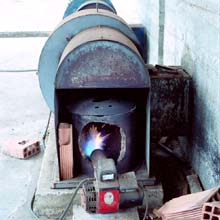 | This is an artificial cocoa drier fuelled
by gas. The heat from the fire is transferred into the metal pipe which
you can see to the right of the burner. The pipe runs under a large
tray of beans, which are dried by the rising heat.
An efficient
artifical drying process can dry beans in one to two days. However,
artificial drying does carry a risk of drying the beans too rapidly, in which case acetic acid will be trapped inside the beans, leading to a highly acidic end product. | 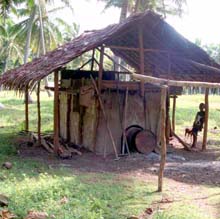 | This picture shows a "cocoa set" in Vanuatu.
This type of artificial drier works on the same principle as the one described above, but it uses a wood fire to generate the heat which dries the beans.
The main risk with this type of drier is smoke contamination of the beans, which can be caused by holes in the heat pipe. | 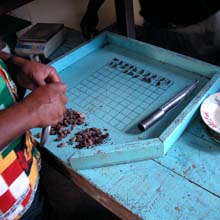 | After they are fermented and dried, the cocoa beans are put into sacks and transported to a central location for grading. In the case of Vanuatu, the beans are taken to the VCMB (Vanuatu Cocoa Marketing Board) in Luganville.
To grade a batch of beans, a random sample of one hundred beans
is selected. Each bean is cut in half lengthwise, and one half is
placed shell down on a grid. Once the hundred samples have been
arranged, they are examined for defects. Defects include mould,
slatiness, insect damage, signs of germination, and flatness. The
number of defective beans is recorded as a per centage of the batch,
and determines the final grade of the batch. | 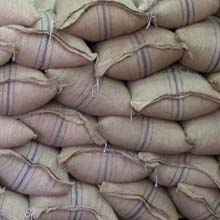 | After grading, cocoa beans are typically packed into 60kg hessian sacks.
Spare a thought for the men who load these sacks into the shipping containers.
I know from experience that even unloading a container full of cocoa is
hard work - and that's with gravity lending a helping hand! |
Some
people tell me that it's better to buy under-fermented cocoa than to
risk buying beans that are over-fermented or rotten. They assume that
growers and processors can't be taught to ferment and dry their produce
properly. But I have seen how a little education can allow small
growers in Vanuatu to produce the best quality cocoa I have sampled.
It's
time for artisanal chocolate manufacturers to realise that their best
chance of obtaining high quality cocoa is if they take a hand in the
education of growers and processors; teaching them what they need, and
how to achieve it - then paying them a fair price for their hard work.
|
copyright © 2005 Tava
|
















